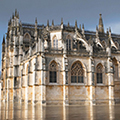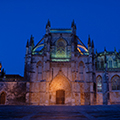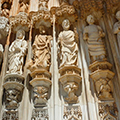
Monastery of Santa Maria da Vitória
The monastery is a milestone in Portuguese history and holds the Royal Pantheon. It represents the victory of Portuguese troops over Castile at the Battle of Aljubarrota in 1385. It is a grandiose Portuguese Gothic building, and shows the new artistic path of the Manueline style. It is a masterpiece of Portuguese architecture, and is one of the most visited monuments in Portugal. The monastery includes the section corresponding to the World Heritage Site. The monastery was built at the end of the 14th century on the orders of D. João I. It required extraordinary human and material resources and the building work went on for almost 200 years. It provided the opportunity to introduce and develop various techniques and arts in Portugal. It includes various styles, due to the large number of architects who directed the works, in particular Afonso Domingues, Huguet, Martins Vasques, Fernão D`Évora and Mateus Fernandes. The last intervention took place in the 1530s, when the Tribune of the Unfinished Chapels was built. In 1907 it was classed as a National Monument.


